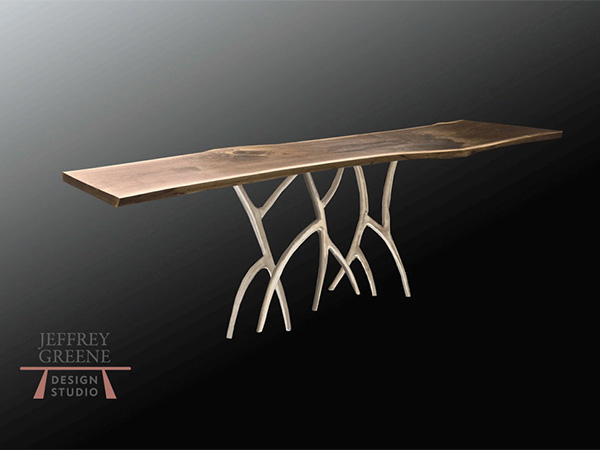
When Jeffrey Greene was just starting out as a woodworker, he was very fortunate to have two experienced craftsmen take him under their wing and teach him both the craft and the business. One was James Martin, a wood sculptor who apprenticed with Nakashima, and the other was Philip Lloyd Powell. They had seen his work, saw he was serious, and taught him about furniture making, how to open a showroom, how to deal with customers, how to acquire quality lumber…the whole nine board/feet.
Though he didn’t know it at the time, the mentoring he received from these men shaped his woodworking career. Over the years, Jeffrey has developed his own apprenticeship program for woodworkers who are just getting their start. To date, he has apprenticed more than 40 woodworkers and more than half of them have opened their own professional shops. It all happened almost by accident.
Once his furniture making business was going, Jeffrey discovered he preferred to work alone. But circumstances conspired against him. First, his mother-in-law fell ill and his wife was away from home for a couple of months taking care of her. So he spent all day alone in his shop only to come home to an empty house. About that time, a guy wandered by and asked if Jeffrey would take on an apprentice. He decided to try it out, and took the fellow on. And it worked out so well, he just kept doing it.
Making Education Pay
Jeffrey realized early that he ended up spending a lot of his production time teaching his apprentices, thereby hurting the profitability of his woodworking business. He decided that, if he wanted to stay solvent, he would need to charge tuition for the apprenticeship program. A tuition-based program made sense, he says, because “I don’t have to put the apprentices on an endless production schedule in order to be able to make it pay.” With the tuition coming in, Jeffrey can afford to teach apprentices a wide array of skills with a much more diverse series of projects. He can also accelerate the program, so apprentices often graduate after a year. The same amount of instruction would probably take about three years in a traditional apprenticeship model, he says, because so much of the apprentices’ time is taken up in production.
Currently Jeffrey has about five apprentices and one full-time employee. The program consists of one big project, a dining room table, some high level cabinet work and an assortment of coffee tables, end tables and whatever else is called for. The dining room table is a center leaf design, with elaborate carving, purpleheart dovetail sliders underneath and a variety of joints. When the table is done, says Jeffrey, it’s so strong “you can stand in the middle of one of these tables when it’s stretched out to 10 feet. It takes a while to make them, but it’s worth it.” The apprentices also make a set of matching dining room chairs.
But the craftsmanship is only part of the education. He also puts the apprentices in charge of projects as they come in and involves them in all aspects of his shop. The apprentices get involved in buying the lumber, helping him design the pieces and building the mockups when needed; they even participate in the delivery of the piece at the end and the cash exchange. He tries to make sure they are involved in most meetings with customers or prospective customers so they can learn how to interact professionally with even the most demanding interior designers.
It Isn’t Easy Being Greene
Of course, with a last name like Greene, you might assume that good furniture design is in his blood. And you might be right. When he first started building furniture, Jeffrey made a conscious effort to avoid the design influences of other woodworkers as much as possible. After doing a lot of design work and quite a bit of furniture, he stumbled upon some pictures of Greene and Greene furniture (which he hadn’t heard of). He saw all the pegged detailing in his designs and the very similar pegged detailing in the Greene and Greene furniture and was amazed. “I couldn’t believe it, I just couldn’t believe it, because there definitely was a similarity,” says Jeffrey.
Years later, a descendant of the Brothers Greene came by his shop. She had a family genealogy that showed he was actually related to the famous Greenes, though the connection went back to a general serving under Washington during the Revolutionary War.
Jeffrey is still running his apprenticeship program, and his wife runs the showroom in a nearby town. His favorite part of the business is creating designs, and refining them, to create classic pieces of furniture that will last far into the future. But his legacy isn’t just the furniture he leaves behind: it’s a whole community of skilled craftspeople that he has shaped over the last 20 years.





